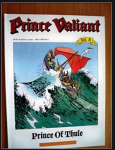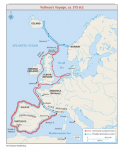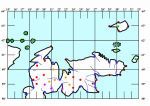Melodi
Disaster Cat
Unless an ancient Greek coin hoard, burial, or other item is found in Iceland this can't be verified but I suspect it is likely to be true, for the same reasons that Nightwolf has always accepted the Brendan Voyages to be accounts of an actual trip to North America by someone who made it there and back. In the case of the Greeks, linguistics and descriptions are used, in the Brendan voyages, there are descriptions of things one only really sees in Iceland and some of the transpolar routes to North America.
The ancient Greeks also knew the Earth was round and even had an astonishingly close to an accurate idea of its size (not exact but almost). I'm going to keep watching this story because as I always say: "in archeology, it is hard to find evidence of something you are not looking for."
 Greek Discovery of Iceland Supported by New Evidence
Greek Discovery of Iceland Supported by New Evidence
By
Paula Tsoni
-
Jan 19, 2021
 The glacier lagoon Jökulsárlón in southern Iceland brings to mind Pytheas’ description of the “island with ice floes close to it”. Credit: Calistemon / Wikimedia Commons
The glacier lagoon Jökulsárlón in southern Iceland brings to mind Pytheas’ description of the “island with ice floes close to it”. Credit: Calistemon / Wikimedia Commons
The Greek discovery of Iceland more than one thousand years before the Vikings is supported by new evidence published in the December 2020 issue of The Housman Society Journal.
Based on an essentially linguistic hypothesis of his own inspiration, Dr. Andrew Charles Breeze pens the latest attempt to shed light on the mystery that surrounds the exact location of the legendary Thule — the world’s northernmost land discovered by ancient Greek geographer, astronomer and explorer Pytheas of Massalia, around 300 BC.
The philology professor at the University of Pamplona, Spain, known for his expertise in historical linguistics, appears convinced that the “island with ice floes close to it” which took Pytheas six days to reach sailing from the north of Britain, can now finally be acknowledged.
“Greeks not only reached India with Alexander, but also discovered Iceland with Pytheas,” he tells Greek Reporter as he starts to unravel his theory.
Long-standing debate
Dr. Breeze compares the old legend of Thule to those of Atlantis or El Dorado.
Pytheas’s original account of his voyages from his hometown of Massalia (today’s Marseille) in Southern France, to Britain and beyond, although well known to ancient scholars, is completely lost —most likely during the fires that destroyed the Library of Alexandria in Egypt.
This is why the scientific community has been struggling for centuries to match the northernmost destination of the famous traveler with an exact location, guided by the rare surviving quotations of his work in later writers such as Strabo, Plinius, and Diodorus of Sicily.
“They call this island Thule, and writers like Vergil and Tacitus and Juvenal use Thule rather vaguely, for somewhere at the end of the known world.
“There have been centuries of argument on where Thule was. Most people say Iceland; some, the Faroes; others, Norway, yet others, the Shetland Isles”, Dr. Breeze explains.
He argues, however, that the key to solving the mystery is a linguistic approach to the matter, and contends that the ancient name given to the island by Pytheas suffered scribal corruption through the centuries to the point that it became unintelligible.
“The trouble is that Thule (or Thyle) means nothing. Emend to Greek Thymele, by adding two letters between the two syllables of the word, and it makes sense. Thymele means ‘altar slab; altar’, and is a common word in ancient Greek”, Dr. Breeze points out.
Mystery solved
In his paper, the professor supports the idea that “the term Thymele was suggested by the island’s south coast, with high and level cliffs of volcanic rock, seen as resembling a Greek temple’s thymele or altar; perhaps the one in the temple (excavated after World War II) at Marseille, where Pytheas came from.
“His name Thymele, early on, lost a syllable through scribal error, and by the time of Vergil (d. 19 BC) and Strabo (active after 21 AD) had become Thyle or Thule.”
 Mist and clouds over the steep cliffs,, black volcanic sand beach and the sea near Mælifell, Iceland. Credit: Alexander Grebenkov / Wikimedia Commons
Mist and clouds over the steep cliffs,, black volcanic sand beach and the sea near Mælifell, Iceland. Credit: Alexander Grebenkov / Wikimedia Commons
As he envisages Pytheas on his first sighting of Iceland, Dr. Breeze believes that “when Pytheas and his men saw the great mass of Iceland arising on the horizon, with clouds and mists rising from it, and perhaps columns of smoke and ash from Hekla and other volcanoes, he thought of the altar in a Greek temple, with fire on top and vapors rising from animals sacrificed there.
“The scribes who copied his work then made mistakes. Letters were lost. Meaningless Thule was the result.”
The paper adds that the case is strengthened on learning that “ancient altars could be immense. The one at Pergamum was forty feet high; others at Parium (near the Hellespont) and Syracuse were said to be two hundred yards long.”
 The glacier Jökulsárlón bears a striking ressemblance to a Greek altar slab, or “Thymele.” Could Pytheas have seen a similar formation as he approached Iceland 2,300 years ago? Credit: Christian Bickel / Wikimedia Commons
The glacier Jökulsárlón bears a striking ressemblance to a Greek altar slab, or “Thymele.” Could Pytheas have seen a similar formation as he approached Iceland 2,300 years ago? Credit: Christian Bickel / Wikimedia Commons
Dr. Breeze says he has already discussed the paper with other classicists and academics at English universities, who certainly thought the suggestion plausible.
“If the hypothesis is right, after more than twenty centuries the Greeks can be recognized as Iceland’s first discoverers, a thousand years before the Vikings.
“The voyage of Pytheas for six days across the North Atlantic was quite as heroic as anything by Columbus. Greeks can feel proud that it was they, and not the Vikings, who were the first to set foot on the soil of Iceland.” Dr. Breeze concludes.
The ancient Greeks also knew the Earth was round and even had an astonishingly close to an accurate idea of its size (not exact but almost). I'm going to keep watching this story because as I always say: "in archeology, it is hard to find evidence of something you are not looking for."

Greek Discovery of Iceland Supported by New Evidence
The Greek discovery of Iceland before the Vikings is supported by new evidence published in The Housman Society Journal.
greece.greekreporter.com
By
Paula Tsoni
-
Jan 19, 2021

The Greek discovery of Iceland more than one thousand years before the Vikings is supported by new evidence published in the December 2020 issue of The Housman Society Journal.
Based on an essentially linguistic hypothesis of his own inspiration, Dr. Andrew Charles Breeze pens the latest attempt to shed light on the mystery that surrounds the exact location of the legendary Thule — the world’s northernmost land discovered by ancient Greek geographer, astronomer and explorer Pytheas of Massalia, around 300 BC.
The philology professor at the University of Pamplona, Spain, known for his expertise in historical linguistics, appears convinced that the “island with ice floes close to it” which took Pytheas six days to reach sailing from the north of Britain, can now finally be acknowledged.
“Greeks not only reached India with Alexander, but also discovered Iceland with Pytheas,” he tells Greek Reporter as he starts to unravel his theory.
Long-standing debate
Dr. Breeze compares the old legend of Thule to those of Atlantis or El Dorado.
Pytheas’s original account of his voyages from his hometown of Massalia (today’s Marseille) in Southern France, to Britain and beyond, although well known to ancient scholars, is completely lost —most likely during the fires that destroyed the Library of Alexandria in Egypt.
This is why the scientific community has been struggling for centuries to match the northernmost destination of the famous traveler with an exact location, guided by the rare surviving quotations of his work in later writers such as Strabo, Plinius, and Diodorus of Sicily.
“They call this island Thule, and writers like Vergil and Tacitus and Juvenal use Thule rather vaguely, for somewhere at the end of the known world.
“There have been centuries of argument on where Thule was. Most people say Iceland; some, the Faroes; others, Norway, yet others, the Shetland Isles”, Dr. Breeze explains.
He argues, however, that the key to solving the mystery is a linguistic approach to the matter, and contends that the ancient name given to the island by Pytheas suffered scribal corruption through the centuries to the point that it became unintelligible.
“The trouble is that Thule (or Thyle) means nothing. Emend to Greek Thymele, by adding two letters between the two syllables of the word, and it makes sense. Thymele means ‘altar slab; altar’, and is a common word in ancient Greek”, Dr. Breeze points out.
Mystery solved
In his paper, the professor supports the idea that “the term Thymele was suggested by the island’s south coast, with high and level cliffs of volcanic rock, seen as resembling a Greek temple’s thymele or altar; perhaps the one in the temple (excavated after World War II) at Marseille, where Pytheas came from.
“His name Thymele, early on, lost a syllable through scribal error, and by the time of Vergil (d. 19 BC) and Strabo (active after 21 AD) had become Thyle or Thule.”

As he envisages Pytheas on his first sighting of Iceland, Dr. Breeze believes that “when Pytheas and his men saw the great mass of Iceland arising on the horizon, with clouds and mists rising from it, and perhaps columns of smoke and ash from Hekla and other volcanoes, he thought of the altar in a Greek temple, with fire on top and vapors rising from animals sacrificed there.
“The scribes who copied his work then made mistakes. Letters were lost. Meaningless Thule was the result.”
The paper adds that the case is strengthened on learning that “ancient altars could be immense. The one at Pergamum was forty feet high; others at Parium (near the Hellespont) and Syracuse were said to be two hundred yards long.”

Dr. Breeze says he has already discussed the paper with other classicists and academics at English universities, who certainly thought the suggestion plausible.
“If the hypothesis is right, after more than twenty centuries the Greeks can be recognized as Iceland’s first discoverers, a thousand years before the Vikings.
“The voyage of Pytheas for six days across the North Atlantic was quite as heroic as anything by Columbus. Greeks can feel proud that it was they, and not the Vikings, who were the first to set foot on the soil of Iceland.” Dr. Breeze concludes.





